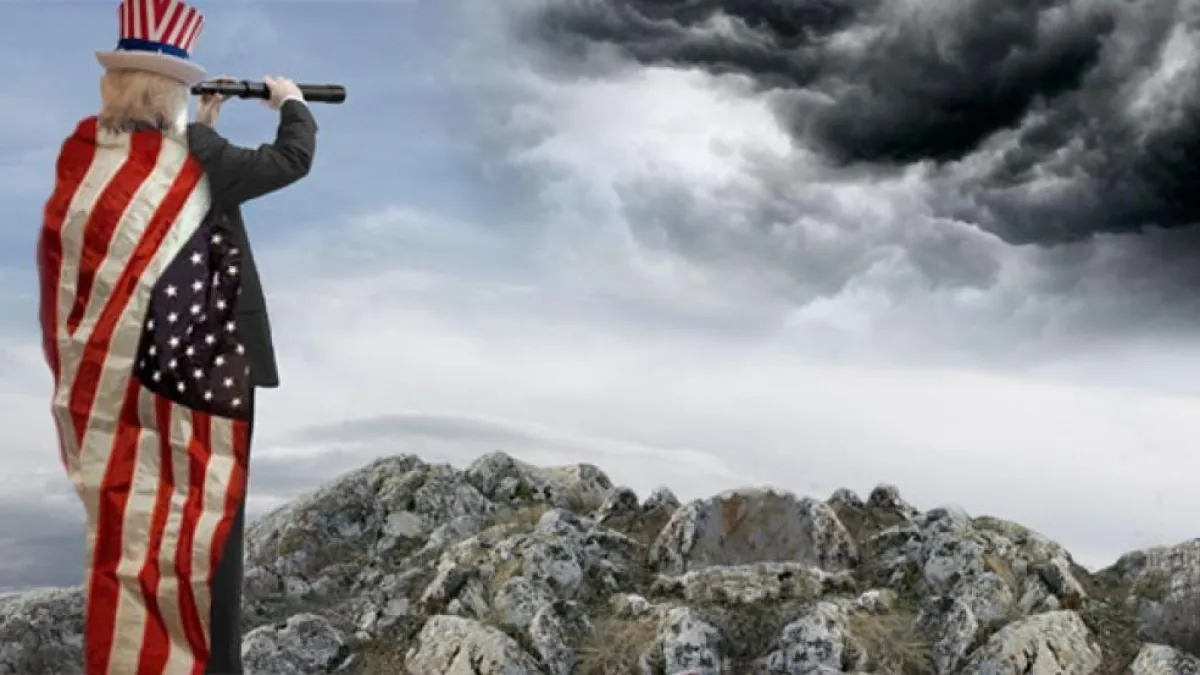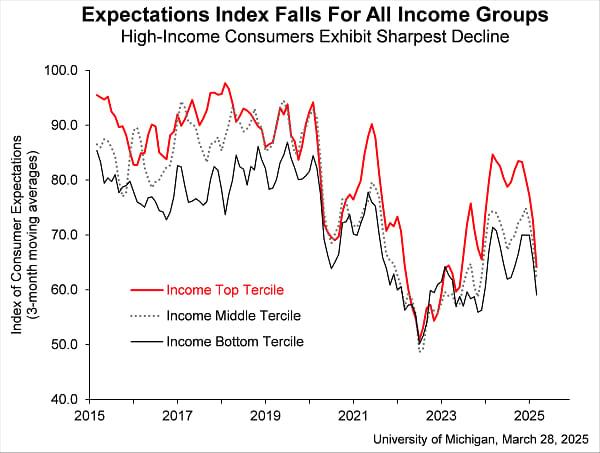
Welcome to the weekend! Next week promises to bring lots of news on tariffs and developments in the push by congressional Republicans for a compromise budget blueprint, which reportedly is being crafted to include two differing sets of instructions on spending cuts - at least $3 billion on the Senate side compared with $1.5 trillion on the House side - in order to maximize flexibility for senators without upsetting House conservatives. The move would essentially put off some tough decisions and likely fights for later in the process.\n\nWe're sure to have more on that next week, but until then, here's what else is happening.
As Trump's Tariffs Loom, Americans Are Growing Very Gloomy About the Economy
A closely watched measure of how Americans are feeling about their personal finances and the future of the economy shows they are growing increasingly worried amid persistent inflation, a rapidly developing trade war and a plummeting stock market.
The University of Michigan's index of consumer sentiment registered 57 at the end of March, falling 12% in just a month while marking the third straight monthly decline. The index is down more than 30% since November 2024, with members of both major political parties expressing worsening outlooks.
"This month's decline reflects a clear consensus across all demographic and political affiliations," said Joanne Hsu, director of the Michigan survey. "Republicans joined independents and Democrats in expressing worsening expectations since February for their personal finances, business conditions, unemployment, and inflation."
The darkening outlook is shared not just across the political spectrum but across the economic one, as well, with more high-income respondents expressing doubts about the year ahead (see the chart below). "Even the rich are worried now," noted Heather Long of The Washington Post.
Long noted that during the Biden administration, many people said the economy was bad but their personal situation was good, while under the Trump administration, it seems that people are reporting that both elements are bad. "Under Trump 2025, people at all income levels are worried they will be worse off in a year," she wrote. "This is the type of situation that causes people to really pull back on spending. This is what is different than 2023 or 2024."
Persistent inflation is one of the key factors in the decline. Consumers see higher inflation on the horizon, with year-ahead expectations rising to 5.0% in March, up seven-tenths of a percentage point since February. Long-term inflation expectations rose to 4.1%, up six-tenths from the month before. Two out of three people answering the Michigan survey also expect unemployment to rise in the coming year - the highest reading since 2009.
A potential pullback in spending and investment, along with the prospect of tariff-driven price hikes and higher inflation, has spooked Wall Street. Stocks had another awful day Friday, with the S&P dropping nearly 2% and the Dow Jones Industrial Average falling over 700 points, or nearly 1.7%.
Core inflation rises: A separate report from the Commerce Department showed that consumer prices increased as expected in February, with the PCE price index rising 0.3% on a monthly basis and 2.5% on a yearly basis. The annual figure is above the Federal Reserve's 2.0% target rate, and roughly the same level since November, suggesting that topline inflation remains at slightly higher levels than the central bank is targeting.
However, the core PCE index, which leaves out volatile food and fuel prices to provide a stronger sense of the underlying trend, came in a bit hotter than expected. Core PCE was up 0.4% month-to-month and 2.8% year-over-year, raising new concerns that inflation is starting to move higher.
Fears of stagflation: Some analysts are even worried that stagflation - a dreaded combination of high inflation and high unemployment - could be brewing, though the economy is a long way from that right now, given the relatively low unemployment rate of 4.1%.
"It shows some preliminary signs of stagflationary pressures," Gennadiy Goldberg, head of U.S. rates strategy at TD Securities, told The New York Times. "This reinforces the narrative that growth may be becoming a little bit more sluggish even as inflation is starting to show some signs of perking up before we really get the brunt of the trade disruptions."
Economists at Bank of America share those concerns, saying this week that "modest stagflation" is the likely outcome for the U.S. this year, with rising prices from the tariffs hampering growth. "The reason that we're a little bit prone to stagflation right now - especially the inflation part - is that our starting point is not very favorable," Aditya Bhave, a senior U.S. economist at Bank of America, told Politico. "You can see in inflation expectations that consumers are already anticipating it to a certain degree - at least in certain measures - and that could become self-fulfilling."
David Beckworth, an economist at the libertarian Mercatus Center, said Friday that whatever negative sentiments Americans may be feeling presently, things could get a lot worse if President Donald Trump's burgeoning trade war goes into full swing. "The American psyche, scarred by the pandemic inflation surge, is not ready for 'Liberation Day' and other price shocks coming their way," he said, referring to April 2, the day when a new round of Trump's tariffs are scheduled to take effect. "This is playing with 🔥🔥."
Trump Says He Had 'Extremely Productive' Call With Canada's New Leader
As we just noted, April 2 - next Wednesday - is likely to be a critically important point for President Trump's economic policy, as he has promised to implement a host of new "reciprocal" tariffs on what he has dubbed "Liberation Day," a day he promises will begin to level the playing field with U.S. trading partners and end years of American being "ripped off."
As Trump prepares to ramp up his global trade war - one that economists broadly expect will raise prices for American consumers and boost uncertainty for U.S. businesses - the president said Friday that he had an "extremely productive" conversation with new Canadian Prime Minister Mark Carney.
"We had a very good talk, the prime minister and myself, and I think things are going to work out very well between Canada and the United States," Trump told reporters.
The call came a day after Carney said that, in light of Trump's tariffs, the old relationship between the two countries, "based on deepening integration of our economies and tight security and military cooperation, is over." Carney also said at a news conference that Canada would respond to Trump's tariffs with retaliatory levies of its own that would have "maximum impact" on the United States.
Trump earlier this month imposed 25% tariffs on Canadian goods, though he quickly limited those tariffs to goods that aren't covered by the rules of the U.S.-Mexico-Canada Agreement. He then imposed 25% tariffs on all steel and aluminum imports. This week he announced 25% tariffs on all imported vehicles and auto parts starting April 2. On a call earlier this month, he reportedly threatened the top executives of some leading automakers not to raise prices because of tariffs.
Trump Administration Moves to Formally Shutter USAID
The Trump administration notified Congress on Friday that, after months of cuts, it is effectively shuttering what's left of the U.S. Agency for International Development, the arm of the federal government that had been responsible for administering foreign aid and development funding, fighting poverty and disease around the world.
The administration took aim at dismantling USAID soon after Trump returned to office, slashing funding and staff. It said Friday that it would absorb some remaining functions into the State Department and discontinue others that it says don't align with its priorities. It reportedly notified the agency's remaining employees that their positions will be eliminated, with the reorganization to be done by July 1.
The agency, which had employed about 10,000 people just a few months ago, will now be reduced to some 15 legally required positions, The New York Times reports.
"Unfortunately, USAID strayed from its original mission long ago. As a result, the gains were too few and the costs were too high," Secretary of State Marco Rubio said in a statement. "Thanks to President Trump, this misguided and fiscally irresponsible era is now over."
The move to shutter an agency created by Congress without legislative approval is expected to face legal challenges.
Trump, Vance Again Press for Greenland to Become Part of US
Vice President JD Vance, his wife, Usha, and other U.S. officials arrived in Greenland today for a controversial, unsolicited visit that comes as he and President Donald Trump continue to talk about the need for the United States to own the island, which is a semi-autonomous Danish territory.
"Greenland is very important for the peace of the world," Trump told reporters Friday. "I think Denmark understands it, I think the European Union understands it, and if they don't we're going to have to explain it to them."
Speaking to reporters at the Pituffik Space Base, Vance made a pitch to the people of Greenland, suggesting that they will be better off if they break away from Denmark: "Our message is very simple. Yes, the people of Greenland are going to have self-determination. We hope that they choose to partner with the United States because we're the only nation on earth that will respect their sovereignty and respect their security - because their security is very much our security."
A poll conducted earlier this year found that 85% of Greenlanders don't want their island to become part of the United States.
Fiscal News Roundup
- Wall Street Tumbles, and S&P 500 Drops 2% on Worries About Slower Economy, Higher Inflation – Associated Press
- Americans Haven't Been This Worried About Rising Unemployment Since 2009, Survey Shows – CNN
- 'Modest Stagflation' Risk Climbs for Trump as Inflation Jumps – Politico
- Trump Warned U.S. Automakers Not to Raise Prices in Response to Tariffs – Wall Street Journal
- Noted Economist Honored by Trump Warns His 25% Tariffs Could Add $4,711 to the Cost of a Vehicle – Associated Press
- US Corporate Profits Hit Record High Before Trump's Tariffs – Reuters
- Judge Orders CFPB to Reinstate Fired Employees, Preserve Records and Get Back to Work – CNBC
- FEMA Blocks $10B in Disaster Aid Over Immigration Concerns – Politico
- Trump Moves to End Union Protections Across Broad Swath of Government – New York Times
- Trump Administration Moves to Formally Abolish USAID – Washington Post
- Top Senate Republican Protests Trump Bid to Withhold Spending – New York Times
- IRS Crime Fighting Arm Announces Modernization Program as Financial Crimes Use More Tech – Associated Press
- Trump's IRS Cuts Are Tempting Taxpayers to Cheat – Bloomberg
- Trump Endorses Budget Fix That Would Restore Washington, DC, Shortfall and Urges House to Pass It – Associated Press
Views and Analysis
- Tariffs Will Destroy the Best Cure for the Trade Deficit – Shannon O'Neil, Bloomberg
- Trump's Giant New Car and Truck Tax – Wall Street Journal Editorial Board
- Tariffs Are Coming for Your Next Used Car – John Authers, Bloomberg
- From Repairs to Insurance, Trump's Auto Tariffs Could Make Owning a Car More Expensive – Wyatte Grantham-Philips, Associated Press
- The Trade Policy We Need – Lori Wallach, American Prospect
- Republicans for the Green New Deal – Wall Street Journal Editorial Board
